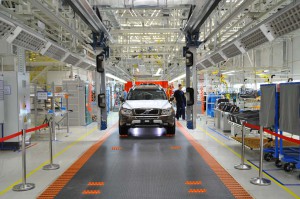The millennium had barely turned before the first Chinese automaker showed up at the Detroit Auto Show promising to begin exports to the U.S. “in a couple years.” A decade later, however, and American motorists are still waiting.
Ironically, it could take a Swedish automaker to finally make that vision come true. Well, make that a Swedish carmaker with a Chinese parent.
Volvo has already indicated it may import a small number of stretched S60 sedans from its Guangzhou plant to the U.S. Now, however, the maker has confirmed that its planned flagship sedan will be produced at another facility in Daqing for export around the world.
“We are fully committed to the growth of our business in China, our second home market,” explained Volvo Cars’ President and Chief Executive Håkan Samuelsson in a prepared announcement. But China will be more than just a second home market. It is quickly becoming Volvo’s second-largest manufacturing base and could soon surpass Sweden itself.
The Swedish maker was sold by Ford Motor to the ambitious Chinese maker Zhejiang Geely Holding in 2010. Since then, Geely has been pumping in billions in investments for new products, powertrains – and a pair of Chinese assembly plants. The one in Daqing reflects the fact that the mega-city’s government holds a 37% minority stake in Volvo Cars.
The plant is currently producing a version of the XC90 localized for the Chinese market, employing 700 workers in the process. It will get a significant upgrade – and a number of new jobs – when the new model debuts. The plant will be retooled to handle Volvo’s Scalable Product Architecture, which means it could be positioned to produce other models, as well.
(Click Here to check out the next-generation Volvo XC90.)
Volvo sales came to 80,000 in China last year, surpassing demand in Volvo’s traditional lead market, the U.S., and, according to the Volvo statement, “It has a long-term goal of selling 200,000 cars a year in the country.”
Even then, it would be difficult to justify operating two separate plants targeting the Chinese market alone, industry analysts contend. And Volvo has confirmed it is looking for opportunities abroad.
The likely first export model will be the long-wheelbase S60, developed primarily for the Chinese bureaucrats and businessmen who prefer to be chauffeured while riding in a luxurious back seat. It could reach the U.S. market as early as next year, which likely would make it the first Chinese-made car to ever go on sale in the States.
But where demand is expected to be marginal, at most, Volvo has far loftier expectations for what it is billing as the “most innovative vehicles in its product range.” Though not called out by name, it is expected to replace the current S80 model and, because of a shift in Volvo’s brand nomenclature, will likely be redubbed the S90.
It will share the underlying platform of the recently revealed XC90 – while Volvo is also expected to add a wagon, or V90, version.
(Volvo looking to add at least 9 new models to line-up. Click Here for details.)
During an August unveiling of the sport-utility model, Samuelsson called it, “the first visible result of the transformation of Volvo Cars since 2010 when it was sold by Ford Motor Co.”
Significantly, the XC90 – and the sedan and wagon versions to follow – will adopt the all-new Drive-E powertrain line-up that Volvo has developed since its hand-off to Geely. The maker is forsaking five- and six-cylinder engines for an all-four-cylinder strategy. For the larger 90-series line, expect an emphasis on the bigger turbocharged Drive-E engine, as well as the upcoming plug-in hybrid package –dubbed the Twin Engine — that will attempt to balance mileage and performance.
(Click Here to learn more about Volvo’s new Drive-E powertrains.)


How sad. What a way to end a company.